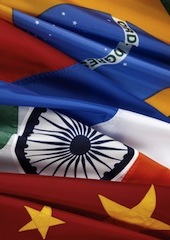Germany, Europe and the Rise of New Global Players
The challenges of a multipolar world.
May 15, 2014

The unipolar phase with only one remaining superpower — the United States — only lasted around 20 years. The simultaneous relative decline of the U.S., Europe and Japan is the megatrend of our time.
To date, the rise of new global players — China, India and the others — has by no means been uniform, nor will it be so in future.
The Chinese model
China — a non democratic, non liberal state — is ascending in the global economic and political hierarchy and could develop a regulatory framework for other states in competition to the West.
During the last 35 years, China has created a highly successful development and moderniZation model which combines authoritarian political leadership with state supervised capitalism.
Bucking big powers
There also are four democratic states among the new global players — Brazil, India, Indonesia and Turkey. They have growing influence, and not only regionally.
However, Western pluralism and free market capitalism are regarded with a certain scepticism even in these countries, as are Western norms and values and the existing liberal world order.
Although most of the new global players share an anti imperialist and anti colonial attitude towards the West, many also regard each other with some wariness.
They also have little interest in tying themselves long term to a powerful partner — whether it is the United States or China.
It would thus be a mistake — despite their summit meetings and the recent decision to establish a development bank of the group — to see the BRICs as a coherent new bloc. Their interests are too different.
We should not forget that these interests are divergent enough, so that they have led to armed conflicts between Russia and China as well as between China and India in the past.
That this potential for conflict continues to exist was demonstrated by an incident at the border between China and India in April 2013.
Manufacturing guns and trading butter
In the course of their economic rise, nearly all new global players have increased their defense budgets and modernized their military apparatus.
Particularly in Asia, rising military spending will likely continue — and in some cases grow. There are longstanding regional rivalries that are now resurfacing, as well as varying reactions and increased nervousness to the perceived U.S. loss of influence. This has raised doubts about the ability of the U.S. to protect its alliance partners.
Many of the new global players are focused on narrow national and, at best, regional interests. In the sphere of global trade, for example, Brazil did not let its strategic partnership with China or the common partnership in the BRICs group prevent it from taking action against China. Together with the U.S. and the EU, Brazil took a case to the WTO, accusing China of dumping.
Global interaction, regional collaboration — if that
What complicates the current situation further is that, despite growing global interdependence, institution-building and political integration are only taking place at regional level — if that.
In South America, Brazil is promoting a new integration project in the Union of South American Nations. Meanwhile, the ASEAN nations are seeking to counterbalance their increasing economic dependency on China with greater cooperation amongst themselves as well as with the U.S., Japan and India.
Beware the hyping
Despite their rise, however, many of the new global players continue to have characteristics typical of developing countries.
Some of them still rely way too much on raw materials and their processing (for instance Brazil, South Africa), while others have only developed a few globally competitive core industries so far (India, for example).
Although the rising economies have all contributed to shattering the West dominated post war order, due to their conflicting interests they are unable, or unwilling, to cooperate constructively on building a new order.
Together, however, we can assume that they are keen, and strong enough, to prevent a new hierarchical order.
Therefore, the future will most likely see a multipolar world. Stabilizing such a global landscape should be a key objective of German and European foreign policy.
Takeaways
The simultaneous relative decline of the US, Europe and Japan makes room for new powers and a changing world
China's ascension provides a new model for modernization and growth
New global powers, like India and Brazil, do not want to tie themselves to powerful partners
nearly all new global players increased their defense budgets and modernized their military apparatus
Growing global interdependence leads to regional, not worldwide, political itnegration
Keen and strong new powers seek to prevent another hierarchical order
Read previous

The Terrible Truth About Income Inequality
May 13, 2014
